| Capcom vs. SNK 2: Mark of the Millennium 2001 | Move List | Gallery | Soundtrack | Achievements | Credits |
"This is the tournament for the new millennium!
You experience the most exciting battle in history!
Let's get ready to battle, build intensity with power and technique barrage!
Crush the competition!
A battle beyond your destination! Let the martial arts madness begin!''
2001 is the year we make contact! Welcome to the revolution!"
-Opening
Capcom vs. SNK 2: Mark of the Millennium 2001, known in Japan as Capcom vs. SNK 2: Millionaire Fighting 2001 (カプコン バーサス エス・エヌ・ケイ
Capcom vs. SNK 2 combines characters and gameplay elements from various Capcom and SNK fighting games, mainly the Street Fighter and The King of Fighters series. Other elements, most noticeably different fighting styles, incorporated elements from other games as well, such as Street Fighter III, Garou: Mark of the Wolves, and the Samurai Shodown series.
Contrary to the previous game, characters no longer have a specific "Ratio". The player can select up to three characters in a team and give an amount or ratio (up to four) to each as he/she pleases. In console versions of the game, players can also choose a 1 on 1 game (like Street Fighter) or a 3 on 3 game (like The King of Fighters) in Arcade Mode with the Ratio System removed.
Gameplay[]
RATIO SYSTEM[]
When creating your team, you have to allocate Ratio Points among your characters that will have a total of four points. Your team can consist of one to three members. Possible combinations are one Ratio 4 character; two Ratio 2 characters; one Ratio 1 and one Ratio 3 characters. A member with higher ratio points allocated has increased offensive and defensive capabilities, thus a greater chance of survival. A player of two characters can beat a player of three characters, and even three characters can beat a single character team. It's all in skill and strategy! So create your own team wisely!
THE GROOVE POINT SYSTEM (G.P.S.)[]
There is a large counter at the top center of the screen known as the Groove Point Counter. As you trade blows with the enemy characters, your Groove Points go up or down depending on how you fight. The total points steadily drop by 0.5 Point after 10 seconds of each match has elapsed. Performing special manuevers and finishing your opponents with special moves or Super Combos is also a great way to boost your score. One of three ratings flash whenever you land a blow or get hit by the opponent, which are further discussed below.
SP : (Super) Attack or maneuver earns 1.0 point and higher. GD : (Good) Attack or maneuver earns less than 1.0 point. PR : (Poor) Groove points decrease by 1.0 point. At the end of each match, the number of ratings are given certain score multipliers and bonus points which are further added to the player's real score. Hefty bonus points are awarded for unscathed victories (Perfect), beating the opposing team with one character (Straight), and beating the entire team without taking any damage (Perfect Straight).
Special points are awarded to the player for defeating an enemy while in the middle of a super or special move, using a special or super move of their own. When this happens, the KO screen will be different, and the finishing move is called Dramatic K.O. (or Finest K.O. in the Japanese version.)
Guide[]
Controls[]
- Note: These are the default control schemes. You can change them at any time with the Options Menu or by pausing.
Battle Controls[]
Characters[]
Capcom Characters[]
From Street Fighter[]
 |
 |
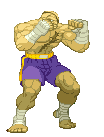 |
 Eagle (newcomer) |
From Street Fighter II series[]
 |
 |
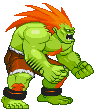 |
 |
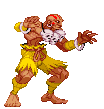 |
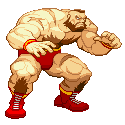 |
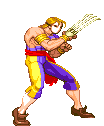 |
 |
 |
 |
 |
From Street Fighter Alpha series[]
 |
 |
 Evil Ryu (Satsui no Hadou Ni Mezameta Ryu in Japan) (Console Version Only) |
From Final Fight series[]
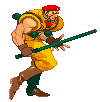 Rolento Schugerg (newcomer) |
 Maki Genryusai (newcomer) |
From Street Fighter III series[]
 Yun Lee (newcomer) |
From Rival Schools series[]
 Kyosuke Kagami (newcomer) |
From Darkstalkers series[]
 |
SNK Characters[]
From The King of Fighters series[]
 |
 |
 |
 |
 |
 Orochi Iori (Console Version Only) |
 Chang Koehan (newcomer) |
 Choi Bounge (as part of Chang's moveset) |
From Fatal Fury series[]
 |
 |
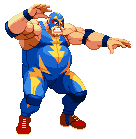 |
 |
 |
 |
Rock Howard (newcomer) |
From Art of Fighting series[]
 |
 |
 |
Ryuhaku Todoh (newcomer) |
From Samurai Shodown series[]
 |
Haohmaru (newcomer) |
From Psycho Soldier[]
 Athena Asamiya (newcomer) |
From The Last Blade series[]
Hibiki Takane (newcomer) |
Mid-Bosses[]
- Note: There are 2 different Mid-Bosses, with all of them requiring different conditions to fight them.
 M. Bison |
||
 Geese Howard |
Final Bosses[]
- Note: Similarly to the Mid-Bosses, there are 2 different Final Bosses, with all of them requiring satisfying two conditions to fight a certain opponent. They can be unlocked after beating them in Arcade Mode.
 Akuma |
||
 Rugal Bernstein |
Secret Bosses[]
- Note: The Secret Bosses are only fought after satisfying two conditions to fight a certain opponent. As one would expect, these Bosses are EXTREMELY challenging, and fighting a specific boss can only happen depending on what Groove you selected. They can be unlocked after beating them in Arcade Mode.
 Shin Akuma (Shin Gouki in Japan; newcomer) |
||
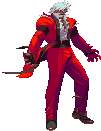 God Rugal (newcomer) |
Stage Cameos[]
- Aomori: Kyoshiro Senryo (as one of the floats on the stage, along with E. Honda and Haohmaru)
- Shanghai: June Lin Milliam (from Star Gladiator), Bao, Chin Gentsai, Mai-Ling (from Red Earth), Li Xiangfei, Hsien-Ko
- Nairobi: Leona, Falcon (from Power Stone), Alex, Clark Still, Ralf Jones, Heidern
- London: Elena (Round 1/daytime only), Karman Cole, Billy and Lilly Kane, Dudley (Round 1/daytime only), Rouge (from Power Stone), Rose (both Round 2/Christmas nighttime only)
Other Cameos[]
- Goro Daimon: Watches some fights between Kyo & Benimaru.
- Kasumi Todoh: Appears during Todoh's intros and win poses.
- Hon-Fu: Appears in Yamazaki vs. Chun-Li intro.
- Mature: Appears in Vice vs. Rugal intro.
- Yang Lee: Appears during Yun's finishing moves.
- Batsu Ichimonji & Hinata Wakaba: Appears during Kyosuke's finishing moves.
- Manari: Appears during Nakoruru's intros and win poses.
Gameplay[]
Capcom vs. SNK 2 is based on the three strength system of punches and kicks (weak, medium, and hard) native to the Capcom games Street Fighter II and Street Fighter Alpha. The overall system is derivative of Street Fighter Alpha. However, a number of different fighting styles called 'Grooves', which mimic other Capcom and SNK games, are included in the engine. These dictate both the character's Super Gauge system (energy for super attacks, or desperation attacks), and special techniques (such as dashes, running, and guard cancels) called "Subsystems". There are six in total, along with custom grooves that can be programmed in home versions of the game. Each player designates prior to the match which groove his or her team will use. Each groove represents a system derived from a different game:
Utilizes a system akin to the one seen throughout the Street Fighter Alpha series, represented by the A-ISM in the third entry. Its main feature is a Super gauge divided in three levels, which fills up as the fight goes on, allowing for the use of Super Moves/SDMs. The power of the button used on such moves, as well as affecting the damage inflicted, also determines how much of the gauge will be depleted (one, two or all three levels). It is also the only groove which allows aerial blocking. Other gameplay features: Dash, Guard Cancel Counterattacks (Alpha Counters in its native game), Rolling Dodge and Tactical Recoveries.
Similar to the V-ISM from Street Fighter Alpha 3, it disables Super Moves/SDMs in favor of Custom Combos, which are combos in which any hits can be strung together into one another. These can be only performed by pressing both Hard Attack buttons when the gauge is full, at which point it will start depleting. Other gameplay features: Dash, Guard Cancel Counterattacks, Rolling Dodge and Fall Breakers.
It uses the classic Super gauge style from Super Street Fighter II Turbo, also utilized in Street Fighter Alpha 3's X-ISM. Consists of a single gauge which fills up as the user deals or takes damage and, when it is full, enables the use of a Super Move/SDM. It also allows for parrying, i.e. repelling an attack to get in position for a counterattack, like in the Street Fighter III series. Other gameplay features: Dash, Short Jump and Tactical Recoveries.
Has a mechanic similar to The King of Fighters '94 and '95 (as well as the Extra mode of '97 and '98), with a power gauge that the player must fill up by having his/her character focus their chi. Low health (the traditional flashing red gauge) allows for infinite Level 1 Supers/SDMs, while Level 3 Supers/SDMs can only be executed in low health and with the power gauge at MAX. True to form, it is the only groove with a sidestep dodge mechanic. Other gameplay features: Run, Short Jump, Guard Cancel Counterattacks and Tactical Recoveries.
Similar to the mechanic adopted from '96 onward: stocks are gained as the power gauge is filled, and with them one may use them up to either use a Super Move/SDM, gain attack and defense buffs for a limited amount of time (also powering up Supers/SDMs) or Guard Cancel into an evasive movement (each of which consumes one stock). Other gameplay features: Run, Short Jump, Guard Cancel Counterattacks, Rolling Dodge and Fall Breakers.
Adopts a system similar to the Samurai Shodown series, with a POW bar, which fills up as the character takes damage. Once it fills up (signified by the 怒/Ikari/Rage icon on fire), the character will flash red and the gauge will start depleting; however, his/her moves become stronger, and he/she will also be able to perform Level 3 Supers/SDMs until the gauge returns to zero and the character is restored to his/her normal color. This groove also borrows the Just Defend mechanic from Garou: Mark of the Wolves. Other gameplay features: Run, Short Jump and Fall Breakers.
Characters Sprites and Graphics[]
Because Capcom vs. SNK 2 features a roster composed of characters from numerous games and hardware eras, the appearances of several of Capcom's characters have been considered substandard in comparison to the newly drawn SNK characters. Instead of choosing to redraw its characters, Capcom took the approach of reusing old character sprites from previous games (mainly Street Fighter Alpha 3) and inserting them in among the other characters. The result created a significant disparity, particularly in the case of characters like Morrigan Aensland, whose low-resolution sprite from the original Darkstalkers games appears washed out and lacking in detail when compared to other of Capcom's newly drawn characters, such as Maki, Eagle, Ryu, Ken, and M. Bison (even Chun-Li and Yun have new sprites, which are based on their CPS-3 sprites from the Street Fighter III series). This has led to criticism of Capcom's art department by critics.
Capcom vs SNK EO[]
Capcom vs. SNK 2 EO is the same game but with minor changes in gameplay, such as adding the ability to cancel Special Moves into Super Combos -- a mechanic found in Street Fighter III series -- and the inclusion of an EO mode ('Easy Operation' for Japanese releases[1], 'Extreme Offense' for European releases[2]) that allows the player to perform specific attacks by simply moving the right analog stick (C-Stick for the GameCube) in a certain direction. Capcom vs. SNK 2 EO also removed the Roll Cancel glitch that was in the original versions.
Like all other home versions of the game, CvS2: EO also contains four bonus characters: Evil Ryu, Orochi Iori, Shin Akuma (Shin Gouki in Japan), and Ultimate Rugal (God Rugal in Japan), powered-up versions of four regular characters. Shin Akuma and Ultimate Rugal are the boss fighters, and display tactics typical of bosses from SNK's fighting games. However, the damage taken by Shin Akuma and Ultimate Rugal is increased to balance their above-average speed and special attacks.
Before selecting a team, the game offers a selection of "Grooves", which change the way the game is played, as well as "AC-ism" or "GC-ism" Grooves; GC-ism simplifies the control scheme, originally designed for the GameCube gamepad. In the Xbox version it's called EO-ism.
In addition, the Xbox version of CvS2: EO also includes online play for up to 2 players on Xbox Live as well as progressive-scan (480p) support, which was noticeably absent in the PlayStation 2 version.
Critical Reception[]
Edge reviewed the GameCube version of Capcom vs SNK 2 EO in issue 114, awarding it only 3 out of 10. It was felt that the special move shortcuts diminished the impact of basic punches and kicks, destroying the game balance; no subtlety, nothing to learn, and no reward. The two player mode was especially criticized: "How can you celebrate some glorious special move victory when all it took was a single movement?".
Trivia[]
- The game is among Capcom and SNK's which has a significant difficulty compensation; the game will lower the difficulty should the player lose at any point in the arcade game, especially at the final battle.
- Losing at any point of the game will not hinder any conditions to fight secret characters; for example, if you lose to M. Bison or Geese and continue, as long as the conditions are met, you will still be able to face Akuma or Rugal, or, Shin Akuma or God/Ultimate Rugal.
- This is the only game in Capcom or SNK properties where there are multiple conditions to face the secret bosses; usually, there is only one set of conditions to face such bosses.
- This game in Japan is subtitled Millionaire Fighting 2001, which is a play on the (un)usual Japanese usage of English terms and words.
- The game's subtitle Mark of the Millennium 2001 is a nod to Garou: Mark of the Wolves.
- In the Gamecube and Xbox versions, the copyright byline for SNK was changed to Playmore, which was at the time, the license holder of SNK-related properties in 2001.
- Capcom vs. SNK 2 is one of four games to be released on all four sixth-generation consoles (PlayStation 2, Xbox, GameCube and Dreamcast), the other games being NBA 2K2, Castle Shikigami 2, and Puyo Puyo Fever.
External Links[]
- Promotional Movie
- Original wallpapers for Gpara
- Capcom vs. SNK 2 Millionaire Fighting 2001 at Sega Retro
| This page uses Creative Commons Licensed content from Wikipedia (view authors). |

